|
TennisOne Lessons A Helping Hand on Your Backhand Volley Doug King One of the most difficult shots for many club players is the backhand volley. Although the volley is generally considered to be a relatively simple stroke, there are a few good reasons why the backhand volley presents some considerable obstacles. In this article I would like to discuss some of these inherent difficulties and in the process take a look at the traditional backhand volley technique, some less conventional alternative solutions, and some practice tips to help you improve. The Continental Grip or the Universal Gripe The most common malady on the backhand volley involves the grip. Over and over I hear the same complaint “Do I have to use this Continental grip on my volleys? Isn’t it okay if I switch my grips? I volley so much better when I change grips.” The bad news is that you really need to learn to use the Continental grip if you are going to become a good volleyer. The good news is that there may an alternative Continental grip you haven’t considered that may work much better for you. Before we delve into that alternative grip, let’s get a better understanding of grips as they apply to volleying. Although in the last 20 years we have seen a great shift in the style of grips used by top players, the Continental grip on the volleys has remained a constant. The Continental is sometimes called the “Hammer” or “Shake Hands grip” for obvious reasons. It can be used on groundstrokes, volleys, and serves. Its basic (though not sole) function on groundstrokes and volleys is two fold – to simplify the stroke by eliminating grip changes and to impart underspin. This is extremely important in the case of volleying as this is most often what is required in topflight play. The difficulty that people have in using the Continental grip with the volley is that it is relatively weak, especially on the backhand side. With the Continental grip the forearm aligns with the top edge of the racquet and almost all of the hand is located in front of the handle on the backhand side. Thus there is very little support of the wrist at contact and it can be very uncomfortable and quite difficult to control. So, if the grip is weak, flimsy, and uncomfortable then a reasonable question is; why should we use it? Net Play -- Power versus Control At the net the emphasis should be on control instead of power. Because we have a shorter distance to hit and because the incoming ball has much more speed when you catch it in the air (it loses a good deal of speed as it bounces and travels a further distance to the baseline) we are often required to take pace off many volleys rather than adding power to them. In fact most pros often miss volleys because they are not able to properly take power off of an opponent’s hard hit ball. Thus as we move forward in the court there is a greater need for finesse rather than power. Also, when we volley, we are closer to the net so we have less time to react and prepare. Therefore, we need to develop a technique that requires less time to execute. Most people’s response to having less time is to speed everything up – but this simply results in over-reacting, over-swinging, and swat volleys. Instead, we must learn how to “minimize” rather than just speed up, that is we need to do less swinging rather than faster swinging. People often think that “good hands” at the net are very fast hands. Actually the opposite is true. Good hands are “quiet hands” that can modulate the power in the shot at the net. When there is less time, the hands must get even quieter. It is the shoulders rather than the hands that need to react quickly. Fast, strong hands often produce excessive backswings on the volley – a sure recipe for failure at the net. The Continental grip is the grip that fits the need for more finesse and more economy. What people at first define as a “weak” and “flimsy” feel will eventually develop into a ”supple” and “controlled” feel. Relying on too strong of a grip will lead to “slapping and swatting” on the volleys. Another way of approaching an understanding of how grips work on volleys is by observing the natural volley progression for most players. When first attempting to volley many beginners (certainly young children) will approach the stroke with a “windshield wiper” technique (using the same side of the racquet face for both the forehand and the backhand in a wind shield wiping motion). Although this apparently eliminates grip changing, it actually represents a grip change to the most extreme degree – so far around that it becomes the same side of the racquet. The reason beginners gravitate toward this technique is because it is extremely strong in the grip. This “uni-grip” aligns the wrist in a position of maximum support, stability, and power and thus provides a certain type of control and accuracy. It also puts the body in a very strong position relative to the contact point and requires relatively little footwork since the body can remain quite frontal for both shots (forehand and backhand volleys).
Players who develop this swat volley style can be quite disconcerting on a number of levels. We have all encountered these aggressive, “unorthodox,” swat volleyers at some point in our tennis career and too often we have been shocked at the results that such “poor technique” can afford. Every time that player smacks a winner I cringe. I can just hear the poor, dispirited, dutiful student on the other side silently cursing the pro for making her agonize over the Continental grip, while her opponent gets to use the “wrong” technique and beats her with it to boot. The fact is that different grips will provide various benefits, and under just the right circumstances, even an “unorthodox” grip can actually work better than the traditionally prescribed grip. If you are hitting volleys from right on top of the net, even the pros will often simply swat them away. But we need to consider the entire scope of what is required in an area of play and from this perspective the liabilities of the swat volley certainly outweigh the advantages. In using the windshield wiper volley there is the above mentioned advantage of strength and power but the stroke will easily be exposed as unsuitable on low balls, wide balls, and shots that require more finesse. If a player using the swat volley is allowed to camp out tight on the net, he may be able to use quickness, nerve, and good athletic ability to obliterate opponents. But if they are moved off of the net with lobs and then made to play low balls from midcourt their technical grip weakness will be quickly exposed. As we progress into higher levels of competition, opponents will be able to hit the ball harder and place it more accurately. What this means in terms of volleying is that as we improve, we will have to be able to handle harder, lower hit balls. This is where underspin and finesse become a necessity in order to be effective. The swat type volley that results from a very strong and active hand position becomes a liability against low, hard hit balls. It will either drive the low ball into the net or if it does clear the net it will surely go over the baseline. The Continental grip and underspin allow you to lift a low ball safely over the net from close range and still keep it in the court. In fact, it is the only real option. So as we progress in our playing level there becomes more of a premium on underspin and control on the volleys as opposed to pure power. The Pro as the Enabler One problem I've encountered is that coaches sometimes inadvertently encourage players in the wrong direction, and this is no truer than on the volley. Because we want people to have success and fun playing tennis, we often allow them to get away with inferior volley techniques by having them stand close to the net as we feed them juicy sitters they can whack away with unbridled glee. Of course it feels good and makes them happy but it also steers them down a dangerous path. It gives them a false sense of what net play is about and leads them to develop faulty technique that can be very difficult to change later on. This swat volley will not only result in improper grips and poor touch but it will also discourage good footwork and weight shift patterns as we will see later. By giving the students a steady diet of sitter volleys, pros often become “enablers,” allowing the students to indulge a craving that can lead to their demise. Okay, I’m a bit dramatic here since there actually is a place for the “swat” volley but it is important that students do not become too dependent on this technique early on in their development. It can be a very, very tempting trap to fall into. This is a recurring theme of fellow TennisOne writer Dave Smith’s and one that I totally agree with. The problem for the pro is to understand the natural difficulties of strength and timing involved in the development of stroke technique and give the student the correct methods of compensation for that deficiency without leaving him either unable to hit a ball near the court or dependent on inferior technique that will undermine progression later on. Learning the Continental grip on the backhand volley is exactly the same situation most players face when learning a Continental grip on the serve. The service grip of choice for most beginners is the Eastern forehand as it is a very strong grip. The Eastern forehand grip will initially produce more power and control but will result in a “swat” hit with a spin that will prove very limiting at later stages of development. What works best for a player will ultimately depend upon how far a player wants to go in the game. A 60 year old woman with little athletic experience just learning the game is not going to Wimbledon and burdening her with the demands of a Continental grip on the serve may be unreasonable. On the other hand, a 10 year old athletic child should learn to get comfortable with the Continental grip as early as possible even if it means hitting a very weak serve for a couple of years. In the end, it will produce the best platform for improvement. Every student requires careful consideration of his or her goals, potential, and commitment when determining development. Developing Volley Footwork and Weight Shift Patterns Making the shift from the windshield wiper, swat style volley to the Continental underspin volley can be very difficult, especially on the backhand. Since there is very little of the hand and wrist behind the racquet handle with the Continental grip making it very weak at contact, the burden of supplying the power is put on the body. This means that we need to learn to generate the racquet movement by using the feet and shoulders more than the forearm and wrist. This is what we mean by “getting the body into the shot” and it is part of every stroke, not just the volley. When we talk about a “stroke” or a “swing” we are simply referring to moving the racquet. This can be done in any number of ways and can come form different areas of the body. The quickest, most flexible, and most powerful way is to simply flick the racquet with the wrist, much like racquetball or squash. This may also be the most comfortable or “natural” way to produce a swing. But you will quickly find that it doesn’t produce very good results for tennis and it can lead to injury. Tennis requires control of the flight of the ball and so an over-active wrist action will spray the ball too much. Still some wrist action is necessary in situations where more power is required. In other situations such as volleys, we are better off minimizing or eliminating the wrist action and relying more on the body to produce racquet movement. An extreme example of using the body to produce the racquet movement is to align the racquet towards a target and then walk to the target without moving anything else. The racquet is moving forward (a “swing” in literal terms), albeit very slowly and rigidly. Although totally insufficient in producing power, the positive aspect of this “walking hit” is that the racquet stays aligned to the target. All of our stroking techniques are based upon these considerations of power and control and, of course, every stroke must conform to the specific conditions of an individual situation. Still a player must develop a range of techniques that cover these various situations, and the volley represents one side of the spectrum that is more dependent on “control” as opposed to power. In a sense, we want to get more to the “walking hit” end of the swing spectrum when it comes to the volley. Exercises to Get More Body into Your Volley A good way to get a feel of this concept of this “walking hit” is to hold a sheet of plywood extended in front of you and simply step against an oncoming ball using a blocking motion. Because of the size of the plywood and the way you are forced to hold it, you can’t actually generate much speed in the board, since additional speed is generated by using the smaller muscle groups in a whip-like motion. By keeping the arms extended and not letting the elbows bend you can put maximum emphasis on the weight shift to generate power. When doing this, try to time your step so that your front foot is coming down onto the ground just slightly after contact. This is a good way to learn how footwork and weight shift timing can be a source of power on the volley, as well as on any shot. Of course the plywood exercise is quite limited as a precise model for the volley since we do not hold a racquet at either end in both hands (this actually gets us back to the overly strong grip position) but it is designed to provide a feel of using the feet rather than the wrist to produce racquet movement. To transfer this same concept of weight shift to a more realistic volley model, imagine instead that you are trying to knock down a door using a shoulder. This would get you turned into the correct position and give you the right feel of bumping against the ball using your shoulder. In fact a good exercise is to stand at the net and have a partner toss you a ball from close range and then try to bump it back over the net using just your shoulder. This will help you to feel the weight shift in a better orientation to the net (sideways). Another exercise that emphasizes using the body rather than a swatting or punching motion and more realistically replicates the actual technique and feel of volleying is to take a bungee cord (about 4 feet long) and attach one end to the racquet face and hold the other end in the non-dominant hand. As you make the volley motion pull the cord straight across the chest by extending the arms, pulling back the shoulders, and pushing out the chest. The attachment of the cord to the racquet should keep the racquet head from snapping or swatting forward while you concentrate on extending the arms using the core areas (shoulders, chest) and stepping with the feet into the ball. You can use the bungee cord as a strength training aid alone or you can incorporate it into controlled hits. Try to time the step into the motion so that you are meeting the ball in mid stride, just as in the previous exercises. The Two-Handed Backhand Volley When lack of strength is a major obstacle in the process a good solution to develop the Continental grip and underspin volley is to use a two-handed stroke. Just as with the two-handed groundstroke the additional hand will provide extra support and control on the volley. If used correctly the two handed volley can provide considerable benefit with minimal cost. The left hand (right-handed player) lends support and stability at contact and also holds the racquet head back much like the bungee cord held the racquet head back in the exercise described above. The two-handed volley also encourages better footwork by reducing excessive arm swing. Essentially what you have with the two handed backhand volley is a mirror image of the forehand volley; that is a left handed and right handed forehand volley. In fact a great way to practice the two handed backhand volley is to play single handed volleys on this side using only your non-dominant hand, being careful to start with slow fed balls.
Although the two-hander has been universally accepted as a viable option on the groundstroke there still remains a great deal of doubt regarding its use on the volley. I would not say that the two-handed backhand volley is the ideal technique; however, the concept of an ideal technique is relative to each player. If a player lacks the strength or experience to effectively employ a one-handed backhand volley he will often resort to failed technique when attempting to execute the stroke. This often takes the form of a poor grip or an uncontrolled arm or wrist action. If there is a solution that can be used that does not have a measurable liability then by all means it should be explored. Often we simply accept things out of convention and certainly the conventional wisdom suggests that all volleys should be hit as one-handed strokes. But deeper analysis can suggest other methods and redefine our opinion of what constitutes “good form.” Remember the one-handed backhand volley has inherent difficulties that can prove too troublesome for some players, especially where strength is an issue. The “ideal” response is to find a technique that rectifies this situation. The two-handed backhand volley can be that solution – especially for two-handed players who have already developed the underlying footwork and weight shift patterns. In fact many two-handed players already use a Continental grip on their normal backhand groundstrokes (they don’t change their bottom hand from forehand to backhand) so they are actually very well suited to an underspin approach on the volley stroke already. In fact many players, past and present have used a two-handed volley. Jimmy Connors used it frequently and Monica Seles almost exclusively. Although they were not necessarily known for their volleying they still managed to get to be the best players in the world so it must have worked for them. And yet even some players who were known for their volleying prowess, such as Hingis, Santoro, and one of the best volleyers of all time, Frew McMillan (if you don’t believe me just ask John McEnroe) used two-handed volleys on the backhand side. The Two-Handed Volley Debate
I have heard many reasons why the two-handed volley is a poor option (not enough reach, too slow, can’t cover the body) but nothing has yet convinced me that this is not a very viable approach for many players. One argument I think may have merit is the advantage the one-hander has on delicately carved shots like a drop volley. In the video of Mary Pierce below you can see that she will use a one-handed shot to play her drop shot but then uses her two-handed volley to put the point away even though she is at a pretty good stretch for the volley. This is evidence that you really don’t gain significant reach by going to one hand and the real advantage in the one-handed volley is that you have more touch and can take pace off of the ball better In using the two-hander it is important not to use the extra hand to snap the racquet head through. Instead learn to use the left hand to hold the racquet back, much like the bungee cord holds the racquet head back in the exercise described above. When you need the extra power to really drive the ball with pace the extra hand will come in very handy as an additional power source – this is quite natural – but the for your basic volley you must learn to use the extra hand for better control of the racquet rather than for more speed and force.
Even though the two-handed volley has more potential for power it is a more controlled power because the two-handed stroke keeps the arms and wrists from getting too sloppy and wild. Even with the power potential increased, I think that many players have shown incredible touch with two-handed volleys, such as Santoro and McMillan as mentioned above, since two hands provides not just more power but also more control. To me the argument that the two-handed stroke is not applicable to the volleys is not convincing. I can guarantee you one thing and that is that the people who say the two-handed backhand volley is a disaster and should never be used can’t do it very well. Even so, by starting with a two handed volley it does not mean the one-hander cannot be used later on as strength develops. I think that in most cases for two handed backhand groundstroke players it makes sense to learn a two handed backhand volley first and then work in the one-hander later on. Any stroke will require a learning period and I think that the learning curve for a player that is already using a two handed groundstroke is going to be much faster by using the same technique on the volley – even if the player switches to one hand later on. Simply put, it is harder to develop “bad” habits with two handed stokes than it is with one handed strokes.
One Hand on the Groundstroke and Two at the Net? If players have the strength to use a one-handed backhand groundstroke then they should almost always stay with one hand on the volley. Even so, learning the Continental grip on the backhand side can be extremely difficult even for one-handed backhand groundstrokers, especially those who use extreme grips on the backhand wing. We see this often with players who extend their thumb up the back of the racquet on the backhand. To get the thumb in this position requires an extreme grip change but it does result in additional support and strength. This can give a player extra “pop” on the shot but when he/she transfers this grip to the volley it will usually result in a swat volley. So even players who use one hand on the backhand will not necessarily be comfortable with the Continental grip and may not easily execute a proper backhand volley. Some of these players may find tat the two-handed technique a comfortable way to get accustomed to the Continental grip. Conclusion Learning the Continental grip on the backhand volley can be a challenging task. The weakness in the grip makes it very difficult to control the racquet. At the beginning stages of our play we lack the strength and the skills of judgment, balance, footwork, and timing that are required to execute this stroke effectively. At the same time we may find that quite often a more comfortable grip will provide better results, so the suffering involved in learning the Continental grip may seem like a poor investment. However it is important to focus on where you want to go in the game. If you want to keep experiencing the fun of learning and improving then the investment is a strong recommendation. The Continental grip on the backhand volley is going to feel awkward for some time – and it may be sometime before you realize that this technique is required to produce the kinds of shots required to win. Like any grip, the Continental grip has it’s limitations so to think of it as an “across the board – fits all volleys” type of technique is unrealistic. Still it is something you will need to get comfortable with, especially to compete at higher levels of play. Fully understanding the costs and benefits of the Continental grip and following a well structured and diligent practice routine will help get you there in the shortest time and with the least amount of suffering. Your comments are welcome. Let us know what you think about Doug King's article by emailing us here at TennisOne.
Doug is one of the country's foremost tennis teaching innovators. Founder of Acceleration Tennis, a revolutionary teaching system, King is leading the way in reinterpreting the traditional tennis model. Doug King is currently Director of Tennis at Meadowood Napa Valley ( www.meadowood.com ), a Relaix Chateau Resort in St. Helena , CA . For more information on Acceleration Tennis please email Doug King at dking@meadowood.com. |

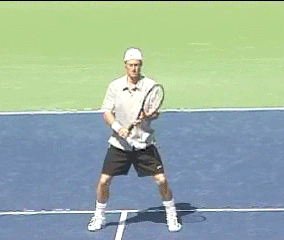
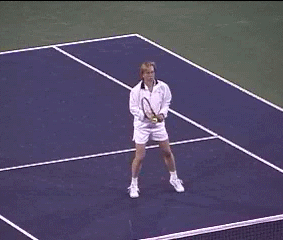
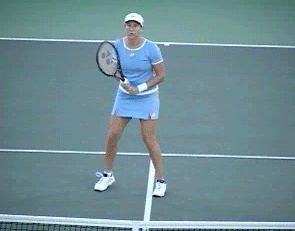
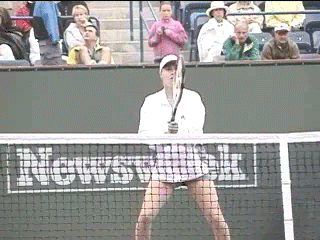
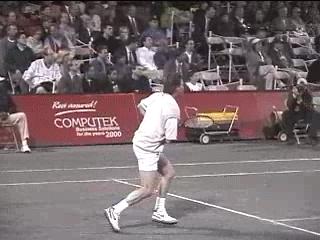
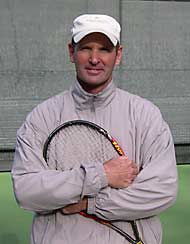
 Doug King studied with legendary tennis coach Tom Stow and was a
former California State Men's Singles Champion
and the former number one men's player of Northern California.
Doug King studied with legendary tennis coach Tom Stow and was a
former California State Men's Singles Champion
and the former number one men's player of Northern California.